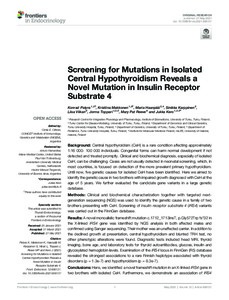Screening for Mutations in Isolated Central Hypothyroidism Reveals a Novel Mutation in Insulin Receptor Substrate 4
Patyra Konrad; Toppari Jorma; Reeve Mary Pat; Makkonen Kristiina; Haanpää Maria; Viikari Liisa; Kero Jukka; Karppinen Sinikka
https://urn.fi/URN:NBN:fi-fe2021093048746
Tiivistelmä
Background: Central hypothyroidism (CeH) is a rare condition affecting approximately 1:16 000- 100 000 individuals. Congenital forms can harm normal development if not detected and treated promptly. Clinical and biochemical diagnosis, especially of isolated CeH, can be challenging. Cases are not usually detected in neonatal screening, which, in most countries, is focused on detection of the more prevalent primary hypothyroidism. Until now, five genetic causes for isolated CeH have been identified. Here we aimed to identify the genetic cause in two brothers with impaired growth diagnosed with CeH at the age of 5 years. We further evaluated the candidate gene variants in a large genetic database.MethodsClinical and biochemical characterization together with targeted next-generation sequencing (NGS) was used to identify the genetic cause in a family of two brothers presenting with CeH. Screening of insulin receptor substrate 4 (IRS4) variants was carried out in the FinnGen database.
Results: A novel monoallelic frameshift mutation c.1712_1713insT, p.Gly572Trp fs*32 in the X-linked IRS4 gene was identified by NGS analysis in both affected males and confirmed using Sanger sequencing. Their mother was an unaffected carrier. In addition to the declined growth at presentation, central hypothyroidism and blunted TRH test, no other phenotypic alterations were found. Diagnostic tests included head MRI, thyroid imaging, bone age, and laboratory tests for thyroid autoantibodies, glucose, insulin and glycosylated hemoglobin levels. Examination of the IRS4 locus in FinnGen (R5) database revealed the strongest associations to a rare Finnish haplotype associated with thyroid disorders (p = 1.3e-7) and hypothyroidism (p = 8.3e-7).
ConclusionsHere, we identified a novel frameshift mutation in an X-linked IRS4 gene in two brothers with isolated CeH. Furthermore, we demonstrate an association of IRS4 gene locus to a general thyroid disease risk in the FinnGen database. Our findings confirm the role of IRS4 in isolated central hypothyroidism
Kokoelmat
- Rinnakkaistallenteet [19250]
